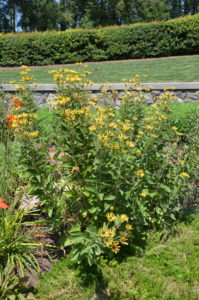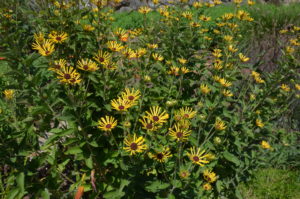Called “sweet coneflower” (Rudbeckia subtomentosum), this U.S. Midwest prairie species is a long-lived perennial that grows in a variety of soils (USDA hardiness zones 4-8). Sweet coneflower prefers full or partial sun (6 hours minimum) and a moist well-drained loamy soils. It is highly drought tolerant after its first year in the garden.
Established plants emerge in mid-spring as a rosette of leaves and grow rapidly to 4-5 feet in height. Basal foliage is toothed, gray-green leaves (lower leaves are 3-lobed). The green stems and leaf undersides have a downy texture, a covering of many fine hairs.
Flowers of ‘Henry Eilers’ are uniquely different — the yellow petals (rays) are rolled instead of flat, giving the flower a quilled appearance. The ray petals surround the purplish-brown dome center. The 3-inches wide flowers bloom in clusters atop sturdy upright branched stems from very late July thru September.
The unique flowers attract numerous bees, butterflies, and seed feeding birds such as cardinals, finches, and jays. Snip flower stems to add to indoor decoration. Deadhead spent flowers to encourage additional bloom. Dark gray-green 3-6 inch long leaves, some 3-lobed, are found around the plant base along with smaller unlobed ones. Leaves emit a mild sweet vanilla or anise smell when crushed.
Fertilize at planting time and annually in the spring with a slow release product such as Osmocote™ or Nutricote™. No serious insect or disease problems trouble this coneflower species. Do not crowd plants as powdery mildew may occur. Taller plants may need some support, particularly if grown in partial shade.
Plants should be propagated by crown divisions in early spring. If grown from seed, only 20% may display the quilled flower trait.
Editor’s note: some species of Rudbeckia spp. are also called “Coneflowers”. In general, coneflowers are in the genus Echinacea spp.



 Posted in
Posted in 
